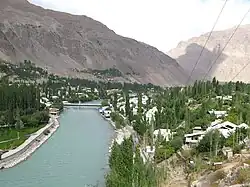| Gunt | |
|---|---|
 Khorog and the river Gunt looking east | |
| Location | |
| Country | Tajikistan |
| Physical characteristics | |
| Mouth | Panj |
• coordinates | 37°29′23″N 71°31′11″E / 37.4898°N 71.5196°E |
| Length | 296 km (184 mi) |
| Basin size | 13,700 km2 (5,300 sq mi) |
| Basin features | |
| Progression | Panj→ Amu Darya→ Aral Sea |
The Gunt (Russian: Гунт, Tajik: Ғунд Ghund or Аличур Alichur, historically in English also Ghund[1]) is a river in the south of Tajikistan, north of the Shughnon Range. It is 296 kilometres (184 mi) long and has a basin area of 13,700 square kilometres (5,300 sq mi).[2] Its source, Lake Yashilkul, is situated at the edge of the Alichur Pamir, a high plateau or pamir at an elevation of 3720m. The city of Khorog is located at the confluence of the Gunt with the Panj (one of the source rivers of the Amu Darya, forming the border between Tajikistan and Afghanistan). See Gorno-Badakhshan Autonomous Region for surrounding area.
The Gunt, and its tributary Shakhdara, power the Pamir I power plant. River flow is very seasonal, low in winter, but high in July and August due to water from melting snow. Its width varies from 10 to 50 meters and it is up to 1.5 meters deep. Due to the mountainous terrain, the rivercourse is very fast, over 2 m/s at times. Its bed is rocky, and the banks are steep and precipitous. Often the stream occupies the whole river valley, but sometimes it divides into several courses.
References
- ↑ "The Geographical Journal". Royal Geographical Society. 1896. Retrieved 16 December 2019.
From its western extremity issues the Ghund or Gunt river, which, after its junction with the Shakh Dara confluent of the Oxus lower down, flows for a few miles under the title Suchan Dara, and disembogues into the main stream of the Panja, a little above Kala Bar Panja, the capital of Shighnan.
- ↑ Гунт, Great Soviet Encyclopedia
